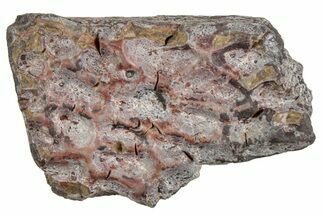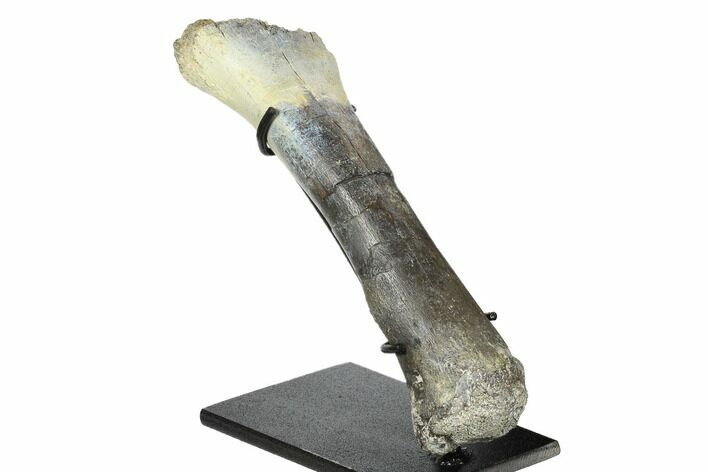This Specimen has been sold.
7.5" Fossil Phytosaur Tibia on Metal Stand - Arizona
This is a well preserved, 7.5" long Phytosaur tibia that was collected from the Upper Triassic age Chinle Formation of Northeast Arizona. Both the proximal and distal ends of the bone are weathered, with the proximal end featuring a white coloration that's likely a result of sun bleaching. There are multiple repaired cracks through the diaphysis, one of which required some gap fill restoration. The other spot that required gap fill restoration is at a break between the proximal metaphysis and the diaphysis. Much of the cortical bone is still intact, revealing the bumpy origin and insertion points of tendons. This gorgeous bone displays nicely on the included custom metal display stand.
There are a variety of phytosaurids that come from this location, making it difficult to conclusively identify individual bones to a specific genus.
There are a variety of phytosaurids that come from this location, making it difficult to conclusively identify individual bones to a specific genus.
About Phytosaurs
Phytosaurs were formidable, semi-aquatic reptiles that prowled Triassic rivers and swamps long before true crocodilians evolved. With long, tooth-studded snouts, armored hides, and powerful, paddle-like tails, they looked uncannily similar to modern crocodiles—but the resemblance was pure coincidence. Phytosaurs belonged to an entirely different branch of the reptile family tree, a striking example of parallel evolution in which unrelated animals independently develop the same body plan to master similar environments. Their lineage appears early in the Triassic, though their exact origins remain debated, and they thrived as dominant freshwater predators until vanishing during the Triassic–Jurassic extinction event roughly 200 million years ago.
Though phytosaurs shared a crocodile’s general silhouette, their heads told a different story. Some species evolved long, needle-toothed jaws for spearing fish, while others developed broader snouts lined with heavy crushing and slicing teeth suited for tackling larger prey at the water’s edge. The largest individuals stretched an astonishing 39 feet—giant ambush hunters capable of lurking just below the surface before erupting upward in a sudden burst of power. Unlike crocodilians, whose nostrils sit at the tip of the snout, phytosaurs carried their nostrils high on the skull near the eyes, allowing them to breathe while nearly the entire head remained submerged, a subtle adaptation that hints at just how refined these ancient predators were.
Phytosaurs were formidable, semi-aquatic reptiles that prowled Triassic rivers and swamps long before true crocodilians evolved. With long, tooth-studded snouts, armored hides, and powerful, paddle-like tails, they looked uncannily similar to modern crocodiles—but the resemblance was pure coincidence. Phytosaurs belonged to an entirely different branch of the reptile family tree, a striking example of parallel evolution in which unrelated animals independently develop the same body plan to master similar environments. Their lineage appears early in the Triassic, though their exact origins remain debated, and they thrived as dominant freshwater predators until vanishing during the Triassic–Jurassic extinction event roughly 200 million years ago.
Though phytosaurs shared a crocodile’s general silhouette, their heads told a different story. Some species evolved long, needle-toothed jaws for spearing fish, while others developed broader snouts lined with heavy crushing and slicing teeth suited for tackling larger prey at the water’s edge. The largest individuals stretched an astonishing 39 feet—giant ambush hunters capable of lurking just below the surface before erupting upward in a sudden burst of power. Unlike crocodilians, whose nostrils sit at the tip of the snout, phytosaurs carried their nostrils high on the skull near the eyes, allowing them to breathe while nearly the entire head remained submerged, a subtle adaptation that hints at just how refined these ancient predators were.
SPECIES
Unidentified Phytosaur
LOCATION
Private Ranch, Northeast Arizona
FORMATION
Chinle Formation
SIZE
7.5" Long, 2.1" wide, 5.9" tall on stand
CATEGORY
SUB CATEGORY
ITEM
#173483
We guarantee the authenticity of all of our specimens.
 Reviews
Reviews















